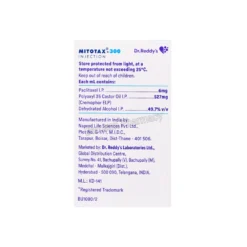Mitotax 300mg Injection
$200.00 – $900.00Price range: $200.00 through $900.00
| Pack Size | Price | Price / Unit | Quantity | |
|---|---|---|---|---|
| 1 Injection | $200.00 | $200.00/ unit | ||
| 3 Injections | $570.00 | $190.00/ unit | ||
| 5 Injections | $900.00 | $180.00/ unit |
Want to order in bulk / B2B price ? | Send Inquiry |


| SKU | 11165 |
| Manufacturer | Dr Reddy'S Laboratories Ltd |
| Categories | Anti Cancer |
| Delivery Time | 10 - 14 Working Days |
| Strength | 300mg |
Introduction to Mitotax 300 mg Injection
Mitotax 300mg Injection is a chemotherapy drug used in the treatment of certain types of cancer. The active ingredient in Mitotax is paclitaxel, which is a taxane class drug. Paclitaxel works by interfering with the normal function of microtubules during cell division, effectively inhibiting the growth and spread of cancer cells.
Mitotax affects the cancer cells by stabilizing microtubules, which are essential components of the cell’s structural framework. This stabilization prevents the cells from successfully completing mitosis, thereby stopping their growth and proliferation. It is manufactured by Dr. Reddy’s Laboratories.
Mitotax 300mg Injection is also used to treat advanced NSCLC (non-small cell lung cancer) when surgery/radiation therapy is not suitable. The medicine is also indicated for use to treat AIDS-related Kaposi’s sarcoma when other treatments (such as anthracyclines) are insufficient to treat the disease in affected individuals.
Uses of Mitotax 300 mg
Mitotax 300 mg is a chemotherapy medication that contains Paclitaxel, and it is primarily used to treat various types of cancers. Here are its main uses:
- Breast Cancer
- Ovarian Cancer
- Non-Small Cell Lung Cancer (NSCLC)
- Kaposi’s Sarcoma
- Other Solid Tumors
How Does Mitotax 300 Works?
Mitotax 300 mg contains Paclitaxel, a chemotherapy drug that works by disrupting the normal function of microtubules, which are essential for cell division. It binds to the microtubules and stabilizes them, preventing their breakdown.
This action halts the process of mitosis (cell division), leading to the death of rapidly multiplying cancer cells. Because cancer cells divide much more rapidly than normal cells, Mitotax selectively targets them.
Side Effects of Mitotax 300mg
Common Side Effects
- Nausea and Vomiting
- Hair Loss
- Fatigue
- Diarrhea
- Appetite Loss
- Mouth Sores
- Numbness or Tingling
- Muscle and Joint Pain
Serious Side Effects
- Neutropenia
- Fluid Retention
- Severe Gastrointestinal Issues
- Heart Problems
Dosage of Mitotax 300mg
The dosage of Mitotax 300 mg (Paclitaxel) depends on factors such as the type of cancer, body surface area (BSA), and patient tolerance. Typically, it is administered as an intravenous infusion at doses ranging from 135 mg/m² to 175 mg/m², usually over 3 to 24 hours every 3 weeks, either alone or in combination with other chemotherapy agents.
Pre-medications like corticosteroids and antihistamines are often given beforehand to reduce the risk of allergic reactions. The exact dose and schedule should always be determined by an oncologist based on individual patient needs.
How to Manage Side Effects?
- Stay hydrated to flush toxins and reduce fatigue or nausea symptoms.
- Eat small, balanced meals to prevent nausea and maintain energy.
- Use doctor-approved anti-nausea medication before and after treatment.
- Get plenty of rest to support your body’s healing process.
- Report any fever or infection symptoms to your doctor immediately.
- Use mild shampoos and prepare for temporary hair loss.
- Practice gentle exercise like walking to combat fatigue and stiffness.
- Follow all doctor’s instructions carefully and attend regular check-ups.
Warnings & Precautions
Here are the key Warnings & Precautions for Mitotax 300 mg (Paclitaxel):
1. Severe Allergic Reactions:
- Paclitaxel can cause life-threatening hypersensitivity reactions. Premedication with corticosteroids and antihistamines is essential before each dose.
2. Bone Marrow Suppression:
- The drug may significantly lower white blood cells, red cells, and platelets, increasing the risk of infection, anemia, or bleeding. Frequent blood count monitoring is required.
3. Neuropathy (Nerve Damage):
- Mitotax can cause tingling, numbness, or pain in hands and feet. Dose adjustments may be needed if symptoms worsen.
4. Liver Function:
- Use is not recommended in patients with severe liver impairment, as the drug is metabolized by the liver.
5. Pregnancy and Breastfeeding:
- Contraindicated during pregnancy due to risk of fetal harm. Avoid breastfeeding during and shortly after treatment.
6. Drug Interactions:
- Can interact with other chemotherapy agents or medications—inform your doctor of all drugs you’re taking.
7. Injection Site Reactions:
- Can cause pain, swelling, or inflammation if the drug leaks outside the vein (extravasation). Administer only by experienced professionals.
Storage
- Store below 25°C (77°F) in a dry place.
- Protect from direct sunlight and heat exposure.
- Do not freeze the vial under any condition.
- Keep in original packaging to maintain stability.
- Shake well before use if precipitation occurs.
- Use diluted solution immediately or store under refrigeration.
Frequently Asked Questions
1. Can I take Mitotax during pregnancy?
Ans. No. Mitotax may cause harm to the unborn baby and is not recommended during pregnancy or breastfeeding.
2. How long will treatment last?
Ans. Treatment duration depends on cancer type, stage, and response to therapy. Your oncologist will decide the best plan.
3. What should I do if I miss a dose?
Ans. Mitotax is administered by a healthcare provider, so missed doses should be rescheduled by your doctor.
4. How to administer Mitotax 300mg Injection?
Ans. Mitotax 300mg Injection will be given to you only by a doctor or a nurse into a vein as an intravenous infusion. Your doctor will decide the correct dose and duration for you depending upon your age, body weight and disease condition.
| Pack Size | 1 Injection, 5 Injections |
|---|---|
| Price/Unit | $180/unit, $190/unit, $200/unit |
Be the first to review “Mitotax 300mg Injection” Cancel reply
Related Products
Anti Cancer












Reviews
There are no reviews yet.